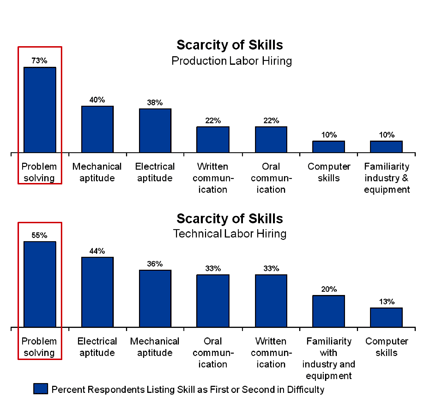The first part of this series on Developing & Engaging the Manufacturing Workforce, a paper by PMMI's Alliance for Innovation & Technical Excellence, looked at the difficulty of locating engineering/technical and production/operations staffing for positions in consumer goods manufacturing. This installment looks at education and training.

|
| While problem-solving skills are critical to processors, they are the most difficult to find in today’s labor market. Source: MESG, Booz and Company analysis. |
“Participants at the workforce engagement session said that our educational system does not teach students how to think,” states the MESG (Manufacturing Excellence Share Group) paper. Children and young adults are not given the tools nor taught the skills to find their way independently through the maze of a problem or a high-level concept. According to MSEG, this deficiency manifests as a lack of decision-making abilities in the workplace.
The research found that when hiring factory labor, people who grew up on local farms, where self-reliance is part of survival, were better at problem solving because it’s a way of life on the farm. In addition, veterans are good candidates because the military trains its people to be extremely diligent in problem-solving. The report also suggests former military junior officers’ leadership experience serves as a perfect criterion for supervisory jobs.
Problem-solving skills are essential for workers since job demands—because of lean operations—require that each individual not only fulfill the role of an operator, but those of a mechanic, quality analyst and a sanitation worker. If that isn’t enough for a day’s work, the same person must also leverage continuous improvement (CI) tools to solve recurring problems and drive cost savings. The study found that in the best high-performance work systems, hourly members of the work team may hold patents and invention records for their efforts, according to Greg Flickinger, vice president of manufacturing and corporate engineering at Synder’s-Lance.
For food and beverage processors that locate near an automotive plant, chances are good local community colleges and engineering schools will support the type of person needed to assume the high-tech roles found in today’s automated plants. But for processors that don’t have other high-tech industries in the area, community colleges may not be as supportive in providing courses that meet the challenges of an automated, lean plant.
|
This means, according to the research, that even in the best case, individual manufacturers need to teach 30 percent of the skills their workers need. For this reason, Hormel built a full-scale training center in its Dubuque plant that mimics the plant floor and is linked to an ancillary computer/video lab for testing and online simulation-based learning. Within this facility, Hormel, like many other food and packaging manufacturers, offers a curriculum focused on continuous improvement and problem solving, two essential training topics for processors, according to MESG.
Dan Sileo, Sunny Delight’s vice president of manufacturing, describes his company’s leadership training program. “We take people and pull them outside of their normal work environments, and give them big, hairy, audacious goals to go out and accomplish. They have mentors who help them along the way, and they typically accomplish much more than they ever thought they could. They then have to do it again.” This hands-on, real-time approach trains workers to think so they don’t have to make a call for help; they figure out problems and correct them on their own.
Finding and retaining talent is a challenge for processors. However, as mentioned in part one of this series, some companies may unwittingly exacerbate the challenge by centralizing the HR function to further reduce costs, distancing HR staff from actively recruiting the most skilled applicants local to each factory. For instance, one major beverage company has a talent acquisition group for the Southern US located in Dallas that serves Memphis, Houston, Dallas, El Paso, San Antonio and numerous other facilities. This kind of arrangement is typically less efficient than having small HR departments do the hiring locally, and can add weeks or months to recruiting efforts.
“The problem is we’re so lean in our manufacturing facilities that if you have five individuals on the manufacturing line and you’re down one, you can’t wait that long for him to be replaced,” says Sileo. “He needs to be subbed for immediately.” When the supervisor has to fill in for the next 10 weeks during the recruiting process, a huge amount of productivity vaporizes, states Sileo.
Retaining talent can be another potential bullet in the foot as processors don’t realize that once they hire a new person, ostensibly from Generation Y, they can’t treat him or her the same way that might have worked with Baby Boomers. According to the research, effectively using Gen Y workers requires a fundamental shift in the manufacturing operating model, from a stable hierarchical system to a dynamic and meritocratic (a system in which the talented are chosen and moved ahead on the basis of their achievement) setting characterized by step change and flexible work practices.
The new workforce tends to multitask and have to be kept engaged. Otherwise, they will become bored within hours, according to John Zermeno, Coca-Cola director of manufacturing. They want their jobs to be demanding and fun—not boring. Unfortunately, as many individuals in Gen Y perceive it, manufacturing was moved overseas and, therefore, is unimportant—not a critical part of the economy nor driving the country forward.
To overcome this perception and the resistance to factory jobs, processors must take proactive steps to show Gen Y candidates that:
- Making things is, in fact, a respected and critical vocation
- The manufacturing environment is suited to their personalities and career aspirations.
The third installment of this series will look further into getting Gen Y interested in food and beverage manufacturing jobs and discuss a 21st century operating model that has the capability of making everyone in the operation more satisfied.




